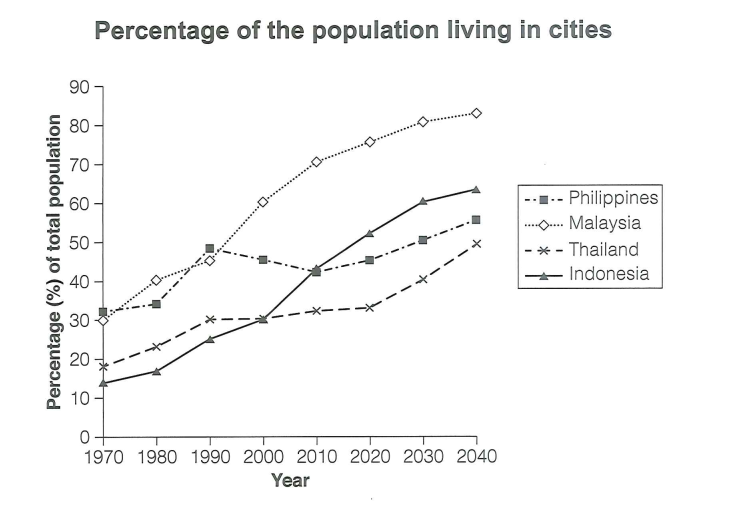
IELTS Academic Writing Task 1: Living in Cities
IELTS Academic Writing Task 1: Living in Cities
Source: Cambridge IELTS Test 18 – Test 1
You should spend about 20 minutes on this task.
The graph below gives information about the percentage of the population in four Asian countries living in cities from 1970 to 2020, with predictions for 2030 and 2040. Summarise the information by selecting and reporting the main features, and make comparisons where relevant.

You should write at least 150 words.
Table of Contents
ToggleIELTS Academic Writing Task 1: Living in Cities Version 1
The line graph compares the percentage of the total population in urban regions in four countries in Southeast Asia from 1970 to 2020, as well as the forecast for two decades ahead. Overall, despite the low population in the 70s, the number of people living in urban areas is expected to increase in Malaysia and Indonesia by 2040.
Around 18% and 12% of the population in Thailand and Indonesia, respectively, were residing in cities in 1970. This percentage gradually increased every decade, and by 2000, three in ten people lived in cities. After ten years, the gap between these countries widened as the urban population in Indonesia increased gradually to 40%. Thailand on the other hand experienced slower growth, reaching a gap of 20% by 2020. It is expected that by 2040, the urban population in Indonesia will reach 60%, a 10% difference from Thailand.
Three in ten people in the Philippines and Malaysia were living in urban areas in the 70s. While there was a slow increase in the Philippines, it managed to reach 50% after two decades, with a small difference from Malaysia. However, after 1990, the percentage of Filipinos living in cities decreased, reaching 40% by 2010, while 70% of Malaysians lived in cities. Although there was an increase to 50% in the Philippines by 2040, the gap with Malaysia is 30%.
IELTS Academic Writing Task 1: Living in Cities Version 2
The line graph compares the percentage of citizens living in cities in four countries in Southeast Asia from 1970 to 2020, as well as the forecast until 2040. Overall, Thailand and the Philippines experienced slower growth compared to the other two countries.
In the 1970s, Malaysia ranked second and Indonesia ranked fourth, with only 30% and 12% of their citizens living in urban areas, respectively. However, the urban population in both countries grew every decade. By 2020, three-quarters of Malaysia’s population and half of Indonesia’s population lived in cities. After two decades, it is expected that these countries will see 10% increase in urban population.
In 2010, only 30% of the population in Thailand lived in cities, a rate that remained steady since 1990. In contrast, half of the population in the Philippines lived in cities but dropped to 40% after two decades. By 2040, it is expected that the percentage of Filipinos living in cities will bounce back to 55%. Meanwhile, Thailand is projected to have steady growth reaching 50%.
Check my other IELTS Writing.
Check my website.

Ian Tanpiuco is an ESL and virtual assistant. With a decade of experience, he has become an expert in his field. Dedicated to helping others achieve their goals, Ian works tirelessly in the classroom or as a virtual assistant.

